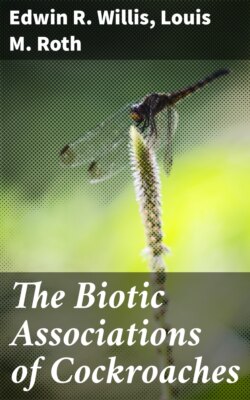Читать книгу The Biotic Associations of Cockroaches - Edwin R. Willis - Страница 298
На сайте Литреса книга снята с продажи.
Parcoblatta pensylvanica
ОглавлениеEastern and southeastern U.S.—Trapped in molasses-baited jars; in oak and in chestnut forests, and on knoll with high deciduous trees. Found in oak and pine woods, under bark of decaying chestnut log and dead chestnut stump, and under signs on trees including oaks (Hebard, 1917).
North Carolina.—In all stages under loose bark of upright, dead pines, when the space under the bark was dry (Brimley, 1908).
Virginia, North and South Carolina.—Under signs on trees (white and red oaks); under bark of dead shortleaf-pine and sweet-gum logs and stumps (Rehn and Hebard, 1916).
Indiana.—Beneath bark of logs and stumps; empty oöthecae common beneath loose bark of logs, especially shellbark hickory (Blatchley, 1920). Under loose bark on logs in January (Blatchley, 1895).
Illinois.—In pine forest associes, in black oak forest on sand, in oak-hickory forest on clay, and in climax forest; it evidently moved into the pine associes nightly, great numbers of oöthecae were found under bark of pine logs, where, in October and November, hibernating nymphs were found (Strohecker, 1937). In nests of Vespula maculata (Balduf, 1936; McClure, 1936).
Missouri.—Usually in hollow trees, under loose bark, in woodpiles, and in cracks in rural buildings (Rau, 1940).
Michigan.—Common in oak-dune and beech-maple forests, under loose bark on dead trees and fallen logs, and under debris on forest floor (Hubbell, 1922). "A characteristic inhabitant of the low shrub-terrestrial and probably the terrestrial-hypogeic stratum." It occurred throughout the upland forests; groups were found established in and under logs 100 to 200 feet from the nearest forest (Cantrall, 1943).
Ontario.—Very abundant in rocky, sparsely-wooded country, where it occurred in rotten logs and under loose bark; on tree trunk at night on rocky island in lake (Walker, 1912).
